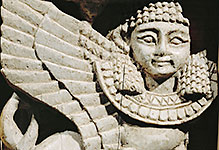
Ancient Middle East
Oriental Antiquities.

#300101 8
Cup in form of a waterfowl, Bronze Age II (1400-1230 BCE). From Enkomi, Cyprus,...

#300101 9
Lid of a pyxis: the queen of the animals feeds her wild goats. 13th BCE, from t...

#30010110
Ivory mosaic, from a piece of furniture. 14th BCE. From Tchoga-Zambil (South-We...

#30010112
Woman holding her breasts; Persian clothing. Persian period, Phoenicia. Bone,...

#30010113
Woman holding a lotus flower. Phoenicia, Persian period. Bone, H: 13,1 cm AO 3...

#30010114
Man with a Persian dagger (akinakes),Phoenician,Persian period. Hippopotamus iv...

#30010115
Swimmer, in braided dress, holding a box. Head and feet were added on. Phoenicia...

#30010116
Two dolls, both from South-West Iran, Parthian period. From Susa, Iran. Bone,...

#30010117
Three nude women, all from South-West Iran, Parthian period, from Susa. Bone....

#30010119
Handle with Mythological Egyptian decoration. The child Harpocrates sitting on a...

#30010120
Handle or case in form of a sphinx, with an Egyptian "klaft" headdress, 1st - 2n...

#30010141
Ivory plaque depicting a winged sphinx, Phoenician, found at Fort Shalmaneser, N...